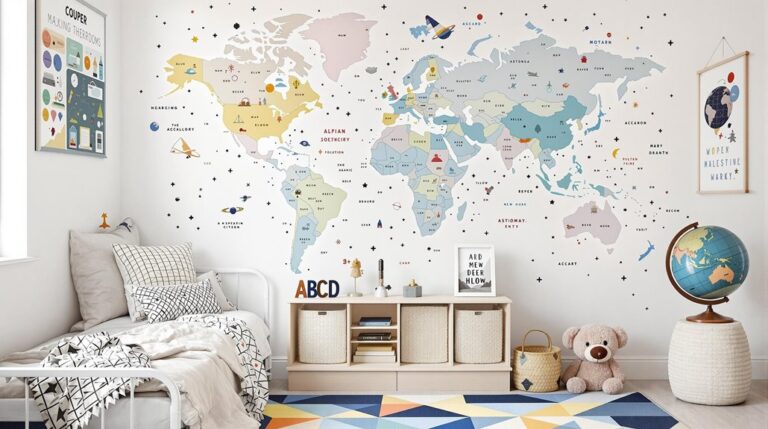When choosing the best color schemes for kids' bedrooms, consider a blend of calming hues and playful accents that spark joy. Soft blues and greens create tranquility—perfect for chasing away the day's chaos. Pair those with earthy tones like gentle browns to bring in the warmth of a cozy woodland. Keep the overstimulating reds and yellows at bay unless you enjoy a nightly circus! Pastel pinks or faded lavenders can add whimsy. Remember to balance serenity with your child's personality for that magical touch, creating a space where dreams take flight. Curious about how to personalize it? Just wait!
Briefly keys
- Soft Blues and Greens: These colors promote serenity, ease anxiety, and enhance concentration, ideal for creating a calming bedroom environment.
- Nature-Inspired Palettes: Incorporating soft greens, earthy browns, and calming blues evokes a peaceful, nature-infused atmosphere perfect for restful sleep.
- Pastel Shades: Faded lavenders and pastel colors foster tranquility and whimsy, helping to create peaceful routines without overstimulation.
- Effective Combinations: Pairing soft blues with white or light greens with white wainscoting enhances natural light and creates an airy feel in the room.
- Personalization: Adding unique design elements and decor inspired by the child's interests fosters emotional connection and encourages creativity in their space.
Calming Color Choices

When selecting color schemes for kids' bedrooms, three key calming color choices stand out: soft blues, light greens, and faded lavenders. These hues not only beautify a space but also create a tranquil atmosphere conducive to relaxation and sleep.
Soft blue, reminiscent of a clear sky, has an almost magical ability to slow heart rates and ease anxiety. Envision a child drifting off to sleep beneath a soothing canopy of blue—serenity personified! This gentle hue is particularly effective because lighter colors positively impact younger kids' mood and wellbeing.
On the other hand, light green shades like sage or faded mint evoke the freshness of spring meadows. These colors promote concentration and health, making them ideal for study corners or reading nooks.
Picture your little one, absorbed in a book, surrounded by gentle greenery—pure bliss!
Faded lavenders, with their soft, dreamy qualities, complete this serene palette by adding a touch of whimsy without overwhelming the senses. They create a serene sanctuary, perfect for imaginative play or peaceful slumber.
In designing a calming bedroom, remember: softer, pastel shades are your allies.
Steer clear of bold colors that might rival a circus tent—after all, we want sweet dreams, not sleepless nights!
Nature-Inspired Palettes
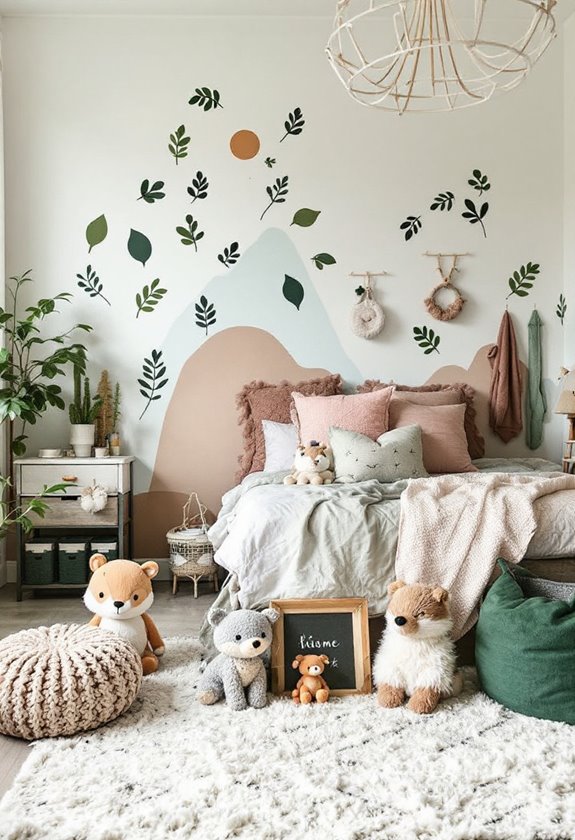
Nature-inspired palettes offer a rejuvenating approach to designing kids' bedrooms, seamlessly blending the beauty of the outdoors with the comfort of home. Envision soft greens like sage and moss wrapping around the walls, creating a serene backdrop reminiscent of a peaceful forest. Accents of lively greens and blues can spark joy, evoking the playful spirit of woodland creatures and wildflowers.
Forest hues and floral inspirations come together to create a dynamic atmosphere. Picture a cozy corner adorned with earthy browns and tans, mimicking tree trunks and soil, while playful splashes of soft pinks and pale yellows dance on the fabric of pillows and curtains. This delightful mix brings the essence of a sunlit meadow right into your child's room. Additionally, incorporating natural wood elements in furniture can enhance the calming environment, creating a space that is both functional and inviting.
And let's not forget the calming blues—those dreamy shades that remind us of clear skies and gentle streams. They provide the perfect counterbalance to lively colors, inviting a sense of tranquility amid the energetic chaos of childhood.
With nature-inspired palettes, you're not just decorating a room; you're crafting a whimsical escape where creativity can run wild, and every nap feels like a stroll through the forest.
Neutral and Earthy Tones
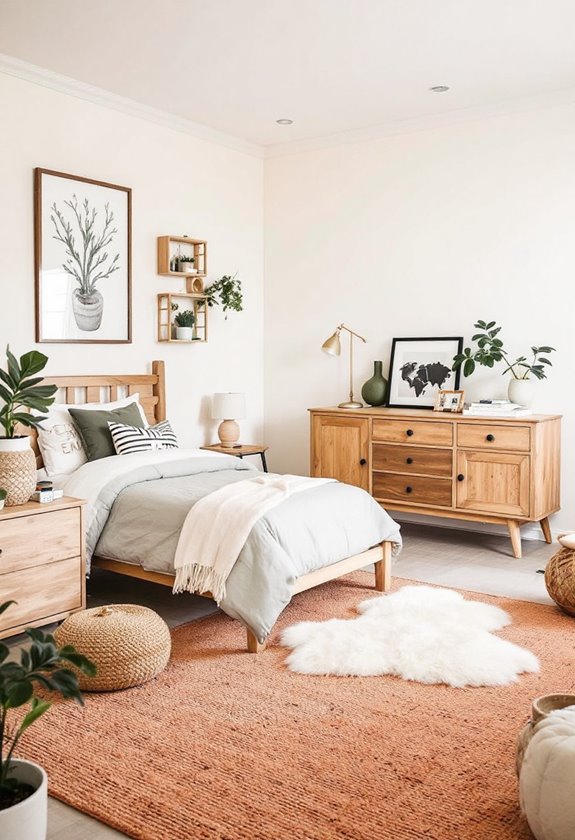
Neutral and earthy tones create a harmonious foundation for kids' bedrooms, promoting a sense of calm and comfort. Think of soft beiges and gentle grays that wrap around your little one like a warm hug after a long day of adventures.
The beauty of neutral color psychology lies in its ability to induce serenity, transforming chaotic spaces into tranquil havens for sleep and creativity. Incorporating low-pigment shades like sage green and pale lilac can further enhance the soothing atmosphere.
Earthy tone benefits extend beyond mere aesthetics. Warm beiges and subtle greens foster a peaceful ambiance, perfect for siblings who might otherwise argue over the last cookie.
Light browns and taupes encourage cozy feelings, like a favorite blanket on a chilly night. Meanwhile, soft greens, reminiscent of a lush garden, invite focus and concentration—ideal for homework sessions that somehow turn into snack breaks.
These shades are not just timeless; they adapt effortlessly to a child's evolving tastes. One moment, it's a jungle theme; the next, it's outer space—without needing a complete overhaul.
So, when considering color schemes, remember: a well-chosen palette can cultivate a nurturing environment, free from overstimulation, allowing dreams to flourish.
After all, who wouldn't want a room that feels like a cozy retreat?
Avoiding Overstimulating Hues
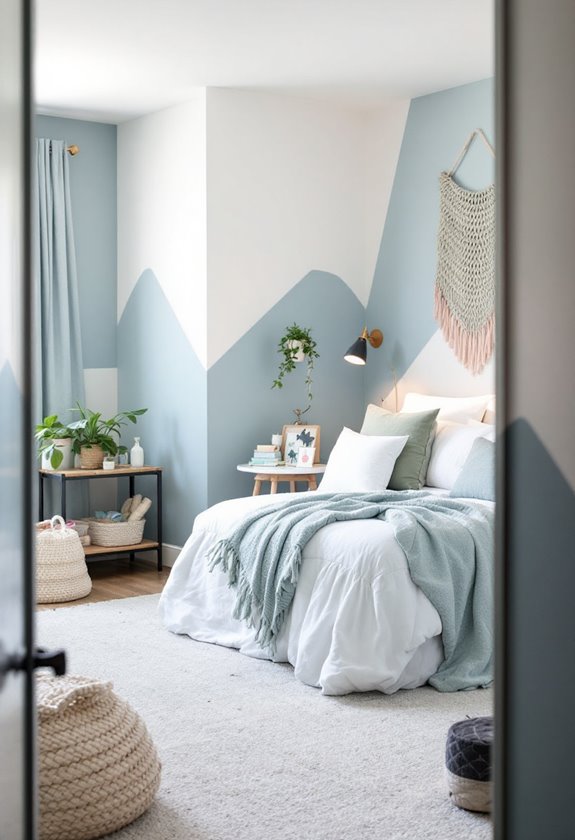
To create a serene and conducive environment for sleep and creativity, it is essential to avoid overstimulating hues in kids' bedrooms.
Color psychology reveals that certain colors can greatly impact emotions and behavior. For instance, while red might ignite passion, it can also raise heart rates and incite aggression—hardly the vibe you want during bedtime!
Bright yellows, while cheerful, can spiral into agitation if overdone, and lively oranges can turn your cozy nook into a chaotic circus.
Imagine a room bathed in bright pink—perfect for a playroom, but not so much for a sanctuary of dreams.
Instead, opt for softer shades that whisper tranquility, like pale pinks or light purples with grey undertones. These colors can foster calmness and relaxation, nurturing a peaceful bedtime routine. Additionally, using cool colors like blue can help lower anxiety levels, making it an ideal choice for creating a calming atmosphere.
Effective Color Combinations
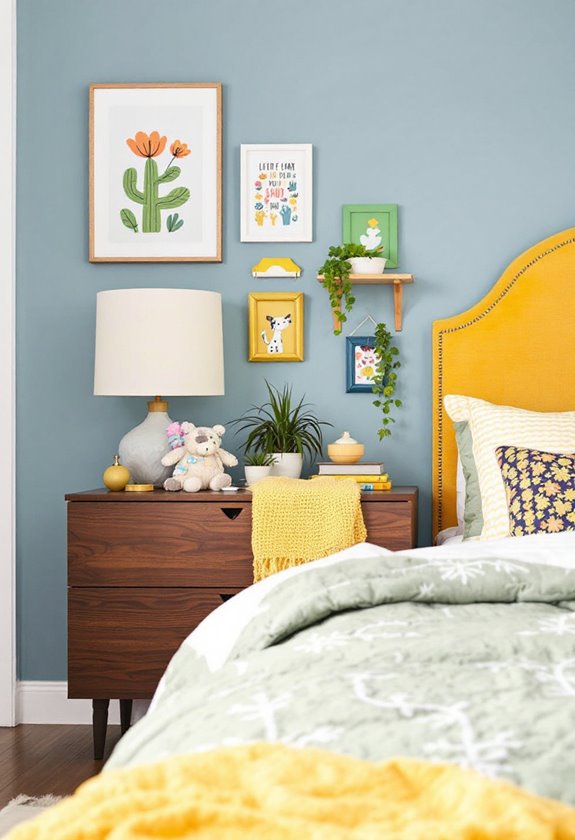
Creating a harmonious atmosphere in a child's bedroom goes hand in hand with selecting effective color combinations. The right hues can evoke emotions and influence behavior, thanks to the principles of color psychology.
For instance, soft blues bring a wave of tranquility, perfect for those rambunctious little ones who could use a little zen. Pair them with white accents or light grays for a serene retreat.
Then there's pastel pink, a delightful choice that can make a statement while keeping overstimulation at bay—ideal for those princess dreams without the sugar rush!
Light greens infuse freshness, enhancing natural light and creating an airy feel; they work wonders when balanced with white wainscoting, which enhances the connection with nature.
And let's not forget about bold yet balanced combinations. Navy blue, for example, strikes a sophisticated note, especially when paired with cool neutrals.
Remember, color trends come and go, but the right palette can evolve alongside your child's interests, from whimsical rainbows to elegant black and white motifs.
Choose wisely, and you'll create a space that sparks joy while ensuring peaceful slumber—because let's face it, we all need a little more sleep!
Practical Color Selection Tips
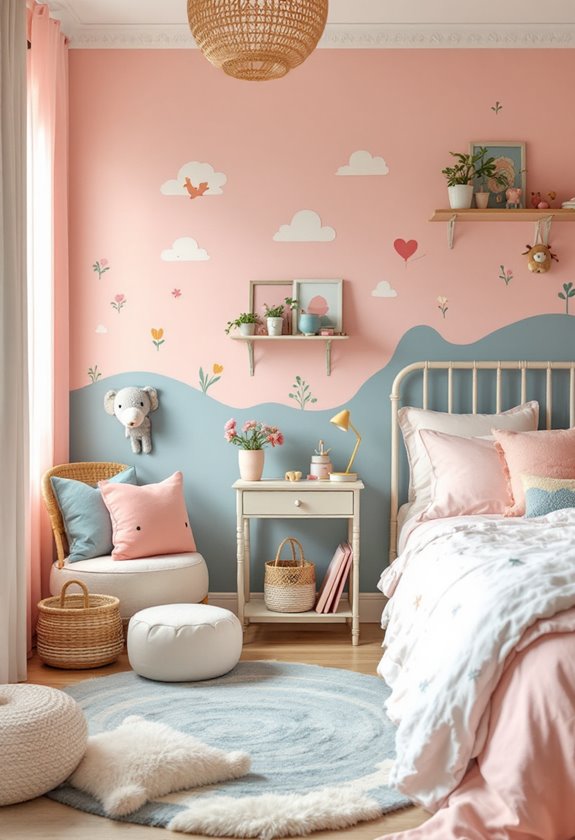
Selecting the right colors for a child's bedroom involves several practical considerations that can greatly impact the overall aesthetic and functionality of the space.
To begin with, think about color durability; after all, kids aren't exactly renowned for their tidy habits. Darker shades like navy or forest green can withstand the inevitable crayon mishaps and sticky fingers, while lighter hues may require a bit more TLC to keep looking fresh. Additionally, consider how durable colors can significantly extend the life of the furniture in your child's room, reducing the need for frequent replacements.
Next, consider your child's preferences. It's essential to involve them in the decision-making process—after all, they're the ones who will be spending countless hours in this space!
Present a curated selection of colors that align with their favorite shades while also promoting a calming atmosphere. Mixing in cooler tones, like soft blues or greens, can create a serene environment, perfect for winding down after a day of chaotic adventures.
Incorporating Unique Design Elements
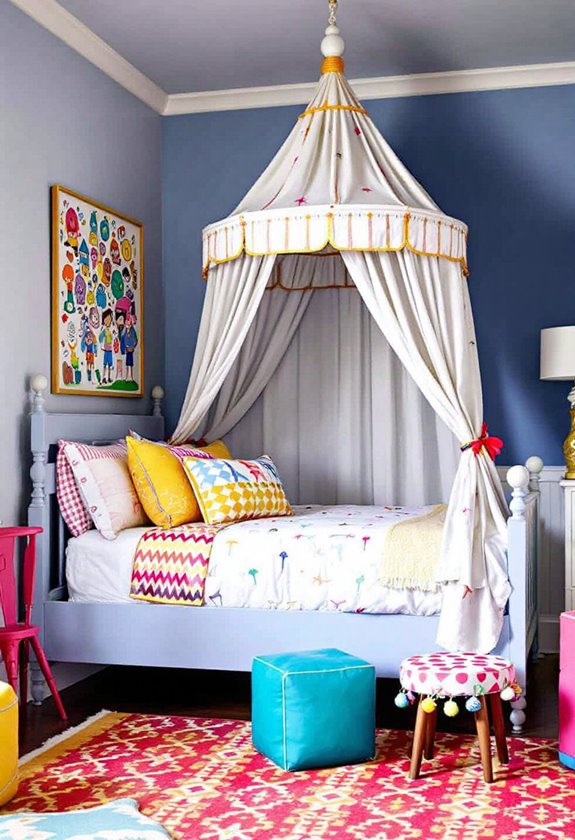
When designing a child's bedroom, incorporating unique design elements can transform the space into a lively and personalized retreat. Think of wall decor that sparks creativity—a colorful floral wallpaper in a girl's room can evoke a garden fantasy, while dark tongue-and-groove paneling might channel a moody adventure for boys.
Don't forget wallpapered ceilings; a whimsical print can transport them into their own enchanted world. Additionally, consider how sophisticated details in the room's design can elevate the overall aesthetic and make the space feel more curated.
Custom furniture is another key player in this design game. Envision a cozy bunk bed snugly fitting in a corner, with reading nooks and built-in desks that make homework feel less like a chore.
And let's not overlook the magic of storage: custom bed frames with drawers or window seats that hide away toys can create a tidy sanctuary.
Throw in some quirky accents—a bright red desk chair, a quirky vintage dresser, or a giant stuffed giraffe—and you've got a room that's not just functional but also bursting with personality.
With the right mix of playful design elements, you can create a space that feels uniquely theirs, like a private kingdom where adventure awaits at every turn.
Creating a Harmonious Space

Often, a harmonious space in a child's bedroom can be achieved through careful color selection that promotes relaxation and well-being. By tapping into the principles of color psychology, you can create a room atmosphere that feels both inviting and soothing.
Envision soft blues, like a sky on a clear day, wrapping your child in tranquility, or gentle greens reminiscent of a peaceful garden, promoting health and concentration. Additionally, incorporating soothing colors can help create a calming environment that encourages restful sleep.
Consider off-whites, such as eggshell or cream, to add warmth without overwhelming the senses. Meanwhile, muted tones like taupe or greige offer a cozy hold, perfect for winding down after a day of adventures.
But beware of the lively sirens—those bold reds and yellows that demand attention like an overly excited puppy. They can disrupt sleep patterns faster than you can say "bedtime."
Instead, balance is key; layer pastels and subtle shades, sprinkling in bold accents for a touch of character without chaos.
Ultimately, the goal is to craft a space where your child can relax, recharge, and maybe even dream about unicorns, rather than fidgeting under the weight of a color-induced anxiety attack!
People are Asking
What Colors Promote Better Sleep for Children?
Calming colors, specifically amber and red, greatly enhance children's sleep quality by promoting a serene bedtime routine. These hues support melatonin production, fostering an ideal sleep environment conducive to restful nights and rejuvenating sleep.
How Can I Make a Small Bedroom Feel Larger With Color?
Why not paint your small bedroom a deep, dramatic hue and invite claustrophobia? Instead, utilize light colors and strategic color contrast to create an expansive illusion, fostering a serene and airy atmosphere conducive to comfort.
Are There Colors That Can Improve a Child's Mood?
Mood-boosting colors, such as warm yellows and lively reds, greatly enhance emotional impact, fostering feelings of happiness and energy. Conversely, cooler tones like blue and green can promote calmness and reduce anxiety, creating a balanced emotional environment.
What Paint Finishes Work Best for Kids' Bedrooms?
In the domain of children's spaces, glossy options symbolize resilience, providing durability and ease of cleaning, while matte finishes reflect subtlety, concealing imperfections. Striking a balance between these finishes enhances both aesthetics and practicality in kids' bedrooms.
How Often Should I Refresh the Color Scheme in a Child's Room?
Revitalizing a child's room color scheme every 3-5 years aligns with evolving color trends and the child's development. Seasonal updates can also enhance engagement, ensuring the environment remains stimulating and relevant to their changing preferences.
Wrapping up
To sum up, selecting the right color scheme for a child's bedroom can greatly impact their mood and overall well-being. Research indicates that colors can influence emotions, with 85% of individuals reporting a preference for certain hues that evoke comfort and happiness. Thoughtful consideration of color choices fosters a nurturing environment, ultimately promoting creativity and relaxation. By employing calming palettes and harmonious combinations, parents can create a sanctuary that supports their child's growth and development.






